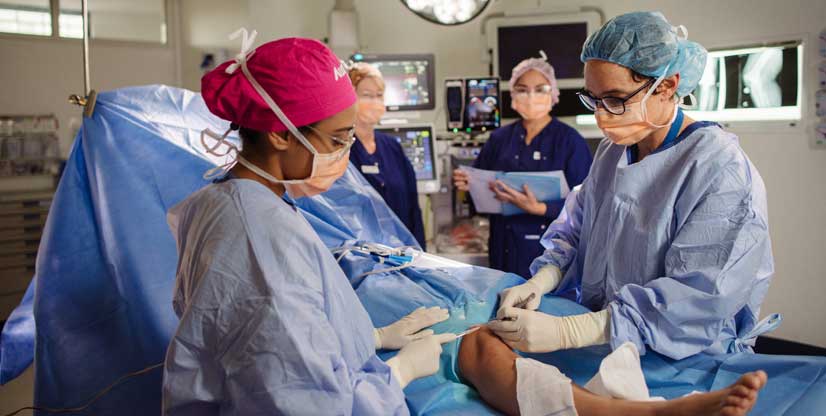Clinics & services
Nerve & tendon transfer surgery
Tendon transfers
- Home
- Clinics & services
- Surgical procedures
- Nerve & tendon transfer surgery
- Frequently asked questions
- Tendon transfers
What is a tendon transfer?
Tendon transfer is when you take the tendon of a working muscle (donor muscle) and re-route it to insert into the tendon of a paralysed muscle or into a bone near a joint, in order to move a joint previously moved by the paralysed muscle and restore function.
Who can have the surgery?
To be suitable for tendon transfer surgery you need to have one or more suitable donor muscles. You are likely to have suitable donors if you have a C5 - C7 complete or incomplete cervical spinal cord injury. Examples of donor muscles include part of the deltoid (a muscle that moves the upper arm away from the body and behind), brachioradialis (one of three muscles that bend the elbow up to the mouth) and extensor carpi radialis longus (one of the three muscles that lift the wrist upwards when your palm is facing the floor). These donor muscles can be considered "spare" as their movement is duplicated by other muscles. You do not lose the original function of the donor muscle but utilise it for a new movement.
You can have tendon transfer surgery at any time once your muscle recovery has plateaued after spinal cord injury. This could be as early as six months after injury but tendon transfers can also be done many years after injury so there is no rush. When you commit to tendon transfer surgery you should be in good health and be motivated to complete the required exercises.
What movements will I be able to do?
Movements that can be restored include:
- straightening your elbow to reach (elbow extension)
- pulling your wrist up (wrist extension)
- actively closing your fingers around an object to allow you to grip or hold it (finger flexion)
- actively closing your thumb against your index finger to pinch (thumb flexion).
The success of surgery will depend on the general strength of other muscles in the arm, the strength of the donor muscles, the flexibility of your joints, your health and your participation in exercises/therapy.
Will my hand work like it did before my spinal cord injury?
No, each tendon transfer can only replace one movement and there are not enough donor muscles to power all the paralysed muscles in the hand. However, successful tendon transfers should improve your hand and arm function.
What does the surgery involve?
The surgery is performed by experienced plastic and reconstructive surgeons at the Austin Hospital. Surgery occurs under a general aesthetic and takes two to six hours. In addition to the tendon transfer, you may require some additional small surgical procedures to your hand to maximise the benefit of your tendon transfer. Tendon transfer may or may not be done in conjunction with selected nerve transfers. Most people are in hospital for two to three nights following surgery.
What happens after surgery?
What you require after surgery depends on the type and number of tendon transfers that you have and if other procedures are completed at the same time. For example, if you have a tendon transfer to replace elbow extension you will need to wear an elbow brace all the time for 8-10 weeks. If you have a tendon transfer for thumb flexion, you will need to wear a forearm-based resting splint for 4-6 weeks. As tendons take up to 6 weeks to reach approximately 95% of their strength, you are likely to need extra attendant care, a power wheelchair and a hoist for this time.
During this post surgery period, you will also need to be able to attend Royal Talbot Rehabilitation Centre for review with the surgeons and for hand therapy. If you have a local therapist, they may be able to assist with some of the rehabilitation and Telehealth reviews with the surgeons and therapists can be organised to cut down on the need to travel. It is possible you will need further procedures in the future to maximise your hand function.
How much does surgery cost?
The surgery and therapy at Royal Talbot Rehabilitation Centre is performed within the Victorian public health system. No payment is required for patients who are eligible for health care under Medicare or who have compensation. You, your insurer or NDIS would be responsible for transport to and from appointments, equipment hire and increased care needs immediately following surgery, as well as exercise equipment and private therapy if used. Self-funded international clients or those not covered by Medicare can be treated by the team via the private healthcare system.
How do I organise an assessment?
Anyone with cervical spinal cord injury can contact the Upper Limb Program therapists to discuss their situation. If appropriate, you will be referred for an appointment at the fortnightly Upper Limb Clinic. At clinic, you will meet the surgeons and the occupational therapists. They will assess your current upper limb function and talk with you about your functional goals. The surgeons will answer your questions and discuss what procedures may be best for you. The surgeons may suggest another type of other procedure or treatment if that is more appropriate.
Where do I find out more information?
You can get more information by talking to your Spinal Rehabilitation consultant or contacting the Upper Limb Program. Tendon transfer surgery has been performed for more than 30 years. Some useful resources are:
'Quadriplegics - tendon transfer surgery' - Better Health Channel (Victoria, Australia)
'Tendon transfer surgery' - American Society for Surgery of the Hand (USA)
(Vancouver, Canada)
'Restoration of Hand Control and Function after Cervical Spinal Cord Injury' - Tetrahand (Sweden)
The Upper Limb Program can also put you in touch with others who have had tendon transfer surgery, but remember every person is slightly different.


